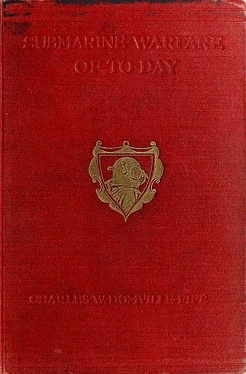In order to get from the deck to this abode of paymasters and writers, except by the tabooed “captain’s hatchway,” there had to be negotiated a long passage leading past the wardroom and the gunroom. In normal times at such an hour this passage would probably have been almost deserted, with the exception of a sentry, but the training was being speeded up to meet the demands of war, and with nearly 200 officers, many of whom fortunately lived ashore, constantly moving to and fro, it became either a semi-dark, congested thoroughfare, in which everyone was curtly apologising for knocking against someone else, or else it contained the steady pressure of a gunroom overflow meeting, with a tobacco-scented atmosphere peculiarly its own.
When the formality of reporting arrival had been completed, the embryo officers were taken in tow by the “Officer of the Day,” whose duty it was to introduce them to the gunroom and make them familiar in a general way with the routine of the ship. The officer who performed this ceremony on the night in question has since held a highly responsible post at the Admiralty—such is the fortune of war.
The first shock came when the work for the following day was explained. It commenced with physical drill on the quayside at 7 a.m. and ended with instruction in signalling at 6 p.m.!
* * *
The early morning was bitterly cold but fine. Physical “jerks” was not a dress parade; in fact, some of the early risers on the surrounding transports and ocean mail boats must have wondered what particular form of mania the crowd of running, leaping and arm-swinging men, in all stages of undress on the quayside, really suffered from.
Breakfast and Divisions were the next items on the programme, and the new-comers looked forward to the day’s work with the keen interest of freshness.
Morning Divisions and Evening Quarters are events of some importance in the daily routine of his Majesty’s ships. They are parades of the entire ship’s company, with the exception of those on important duty, marking the beginning and end of the day’s work. The crew, or men under training, are mustered in “Watches,” under their respective officers, and stand to attention at the bugle call. The senior officer taking divisions then enters, a roll is called and the names of those absent reported. The chaplain stands between the lines of men; the order “Off caps!” is given and prayers commence. When these are finished certain orders of the day are read out to the assembled ship’s company and the parade is over.
At evening quarters, on certain days in the week, the names were read out of the officers and men detailed for special duties or for draft to a zone of war.
When morning divisions were over the day’s work began. The embryo officers were attached to the seamanship class, consisting of about twenty men of all ages. Oilskins were donned, for the sky was overcast and the wind keen. They climbed down the steel sides of the cruiser on to the small deck of a tender, which was to convey them out on to the broad but sheltered waters where much of the preliminary practical training was to take place during the following weeks.
The instructor, an officer attached for the purpose, then divided his class into two “watches,” one being directed to work out the proposed course of the ship on the charts in the cabin and to give the necessary orders to the other watch on deck, who were to carry them into effect as the ship steamed along, with the aid of sextant, compass, wheel, engine-room telegraph, lead and log-line. As all possessed some knowledge of the sea, and had experience in navigating, this work did not prove as difficult as it undoubtedly would to anyone entirely devoid of nautical knowledge.
Those in the cabin with the charts worked out the compass courses from one point to another, making the necessary allowances for tide, deviation, etc. Others of the same watch received reports from the “bridge” and made the correct entries in the log-book. All elementary work, but which needed practice to make perfect, and on the accuracy of which men’s lives would depend in the very near future.
The watch on deck was engaged in the more practical work of coastal navigation and could see the effect of any mistake made theoretically by their companions below. At midday the watches were reversed. Those working at the charts and courses came on deck and the seamen of the morning became the navigating officers of the afternoon.
On this particular day the second or port watch had the worst of it. A squally wind and rain had set in, making the work on deck thoroughly wet and uncomfortable. An hour or so later the small ship was rolling and pitching and everyone was drenched. The lead was kept going by hands numb with cold—a foretaste of the long and bitter days and nights to be afterwards spent in wintry seas.
The training cruises were continued for many days and were interspersed with lectures on the elements of good seamanship, the more advanced theory and practice of navigation being left for a later course at the Royal Naval College, Greenwich.
After seamanship came gunnery. Each of the different types of heavy but finely made weapons had to be learned in detail—a feat of memory when it came to the watch-like mechanism of the Maxim. Guns were disabled and had to be put right. They missed fire and were made by the instructors—old naval gunners—to play every dastardly trick conceivable. The final test which had to be successfully passed was the dismantling of each type of gun used in the auxiliary fleet and the reassembling of it.
With gunnery came also the marks and uses of the different kinds of ammunition, the systems of “spotting” and “range-finding.” Every gun had its officer crew and the rapidity of fire was recorded. Each man in turn was chosen to give the necessary orders and to judge the ranges and deflections. In this way not only was the practical work learned by heart, but also the theory of naval gunnery, so far as it related to the smaller types of weapon.
The use of the depth charge, both mechanically and tactically, was expounded and practically demonstrated, together with that of the torpedo, the mine, mine laying and sweeping, and the peculiarities of various explosives. Rifle and revolver practice was encouraged, and morse and semaphore signalling formed part of the daily routine.
The training was not entirely preparatory for work afloat. Squad and company drill, rifle and bayonet exercise, and manœuvring in extended order formed a part of the comprehensive training. One day, not many weeks after their arrival, the officers whose fortunes have been followed found themselves shouting orders and directing by arm and whistle lines of dusty camarades advancing over a common in the most approved military fashion.
The training was not all hard work. The gathering of so many men from all quarters of the world, with a wealth of experience and adventure behind them, was in itself a source of mutual interest—and incidentally an education in modern British Imperialism. Scarcely any part of the world went for long unrepresented in either the wardroom or gunroom of the old cruiser Hermione in those days of war, and many were the yarns told of Alaska days, hunting in Africa, experiences in remote corners of North America, pearling in the Pacific and life on the Indian frontier, to say nothing of wild nights on the seven seas. Grey heads and round, boyish faces, the university and the frontier, with a camaraderie seldom equalled.
The period of training in the old cruiser was drawing to a close when each officer was appointed to “Boat Duty.” There were five launches on duty at a time, and their crews had to be instantly ready day and night. The most coveted were the two 21-knot boats, used almost exclusively for the conveyance of pilots to and from the hospital ships and transports. Then came the patrol boat, a slow old tub with a comfortable cabin, and work out on Southampton Water at night. The three “duty boats” were for emergency use and were held at the disposal of the naval transport officer.
Читать дальше












